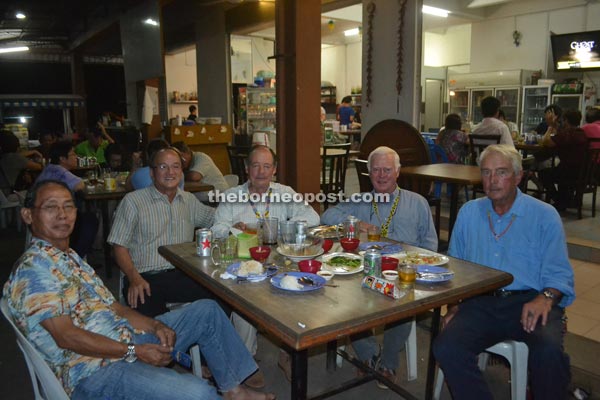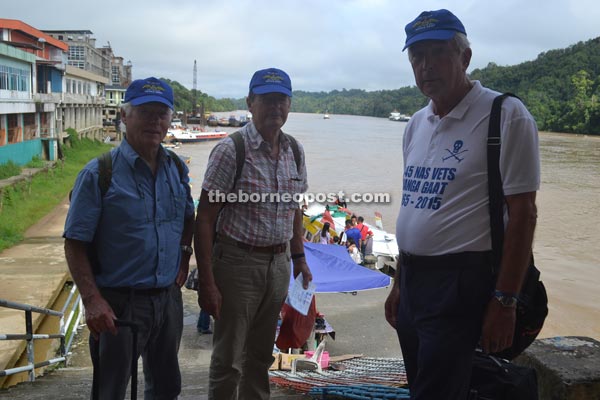
(From left) Wilfred, Kapitan Micky Ngu, Donkin, Thompson and Burns-Thomson enjoy a meal together.

(From left) Thompson, Donkin and Burns-Thomson at the Kapit Waterfront.

A file photo of the memorial at Nanga Gaat.

An aerial photo shows the camp at Nanga Gaat during the Confrontation.

The navy pilots with Iban trackers at Nanga Gaat.

Personnel check on a Wessex helicopter that crashed in the jungle.
KAPIT: Three former British helicopter pilots from the 845 Naval Air Squadron returned to Nanga Gaat, Baleh River on Monday to pay their respects to their fellow servicemen who perished during the Indonesian Confrontation from 1964 to 1965.
They visited the memorial column set up 50 years ago in memory of the British Security Forces.
Brig Gen Tim Donkin (retired), Lt Michael Thompson (retired) and Lt Neil Burns-Thomson (retired) once piloted Westland Wessex and Whirlwind helicopters, serving alongside some 40 others here during Malaysia’s early years of independence.
“We were based at Sibu Airport, command headquarters, on rotation for 18 months’ tour of duty and two months on the carrier HMS Bulwark in the South China Sea. We supported the army as a forward operating base from Kanowit to Belaga. We flew regularly from Sibu to Kanowit, Song, Kapit and Belaga,” explained Thompson.
Donkin, 77, said Nanga Gaat was the British military’s forward operating base to support the military operations at the border and along the Hose Mountain Range.
“There were so many operation posts stationed by the (Royal) Malay Regiment and British soldiers and our role was to support their operations, to provide transport and logistics.
“Those on border duty were on a rotation basis (every fortnight). We air dropped rations and provided transport for the army personnel,” he said.
The 73-year-old Thompson also recalled a mission where he nearly lost his life.
“One day in March 1965, I was flying the Wessex helicopter. Because of engine failure, the helicopter plunged and crash-landed in a small river in the forest near to Nanga Puro.
“I suffered a broken backbone. The accident happened at Sungai Puro, Nanga Gaat, Baleh River. When the helicopter failed to return, Neil Burns-Thomson came to look for me and on a stretcher I was sent to Lau King Howe Hospital, Sibu where (Tan Sri) Dr Wong Soon Kai (former Deputy Chief Minister) operated on me. I survived the crash and the Ibans there gave me a name ‘Antu Gayu Sungai Puro’.”
Malaysian Armed Forces Veterans Association Kapit branch chairman WO Wilfred Billy Panyau (retired) said there were six personnel from the Royal Malay Regiment and one from the British Army on board the helicopter.
“There were seven soldiers on board who perished in the tragedy. The Malay soldiers were recovered but the Briton has never been found,” he said.
Burns-Thomson, 77, also experienced a brush with death while serving here.
“I was flying the helicopter Whirlwind 7 on the way from Nanga Gaat to Long Jawie, Belaga. Midway, the control system failed and crashed into the primary jungle. First it hit the treetops and then crashed onto the forest floor.
“There were four on board and we all survived. Not far away, the Ibans were planting padi. They saw the crash and came to our rescue. They thought we had died and when they saw us only suffering from minor injuries, they gave me the name ‘Antu Gayu Nanga Merama’.
“With the help of the Ibans, we managed to climb up the hill and luckily by then Michael and Tim Donkin came to search for us,” he recalled.
Burns-Thomson was also involved in a mission on a Whirlwind armed with SS11 missiles, which destroyed an Indonesian observation tower built at the Sarawak border in what was then Simanggang (Sri Aman).
All three men kept in touch over the years and planned the trip to Nanga Gaat a few months back.
They travelled by longboat for an hour from here to Nanga Gaat to pray at the memorial and then visited what was their base camp before dropping by Rumah Tinggang, which was the nearest longhouse to the camp.
“It played a very important role in those turbulent years for military intelligence of any enemy movements or attacks on the base camp.
“The Ibans there were excellent jungle trackers and they would inform us of the Indonesian intruders in the vicinity. Before they struck, we captured them first,” said Burns-Thomson.
Wilfred added that the sacrifices of the British and Allied Forces should never be forgotten.
“Today, we would not be able to enjoy the peace, prosperity and development of this country. Together with the locals, they fought to defend us from external aggression in 1964 to 1965. We salute and thank them for everything in the making of a modern Sarawak,” he said.
Thompson served for eight years as a navy pilot in East Asia.
After he retired from active service, he flew civilian helicopters in the North Sea for oil exploration companies and later worked in Brunei from 1974 to 1996.
He now resides in Kerikeri, New Zealand with his wife.
Burns-Thomson, who learnt to speak Malay while in Singapore, served in the navy from 1960 to 1972.
“Back in England, I started my own business first as an office cleaner and later a landscape gardener. I have four kids,” he said.
Donkin served from 1958 until 1992 when he retired as Brigadier-General.
During the Falklands War, between the United Kingdom and Argentina in 1982, Donkin was the military spokesman for the late Baroness Margaret Thatcher, who was then Prime Minister.
